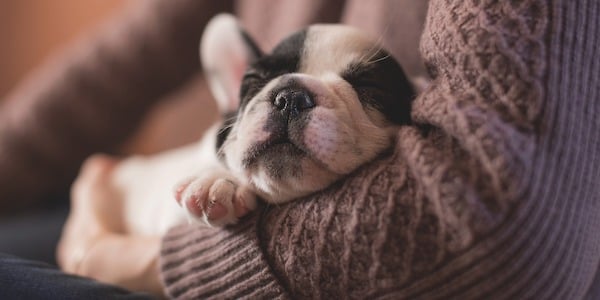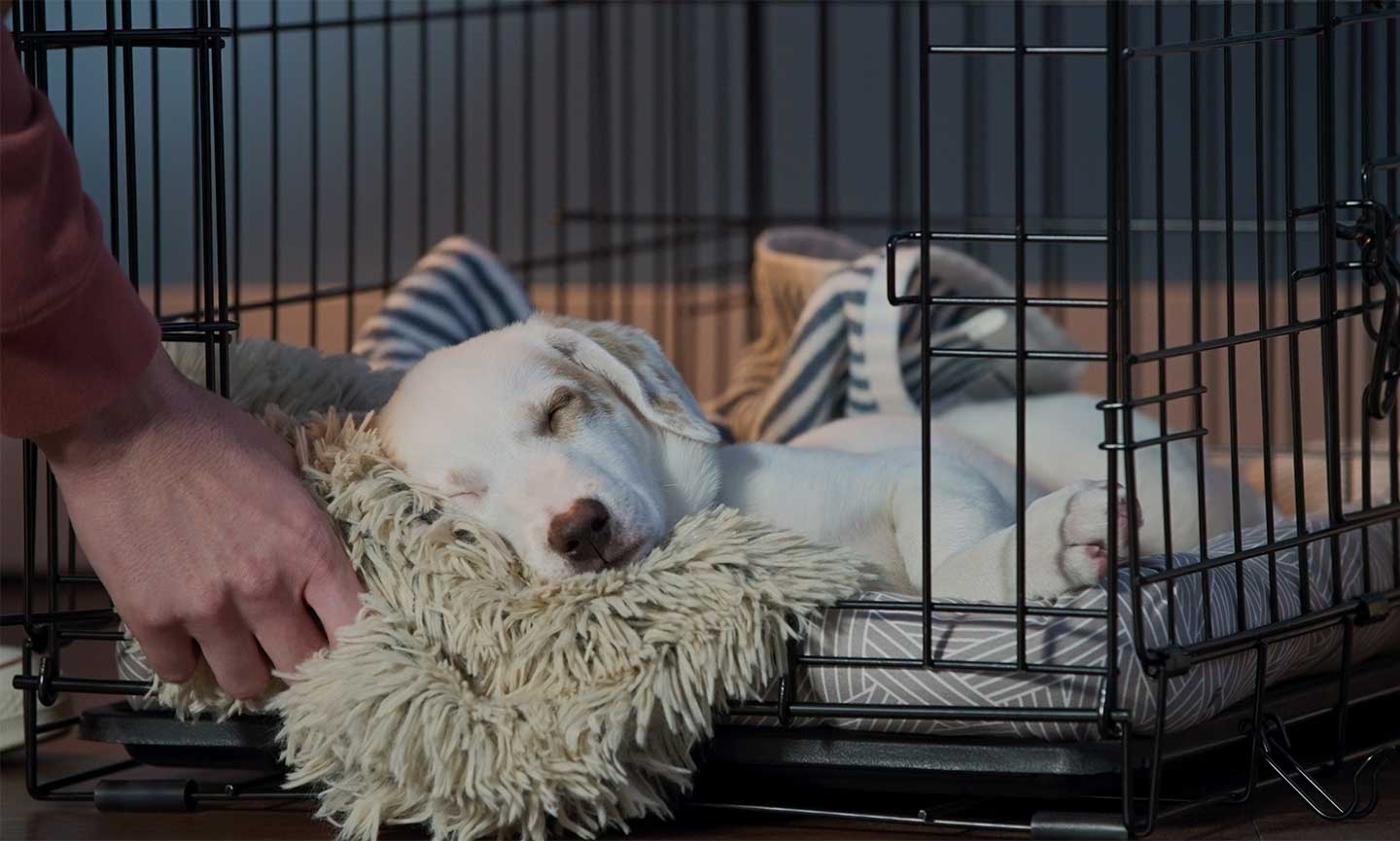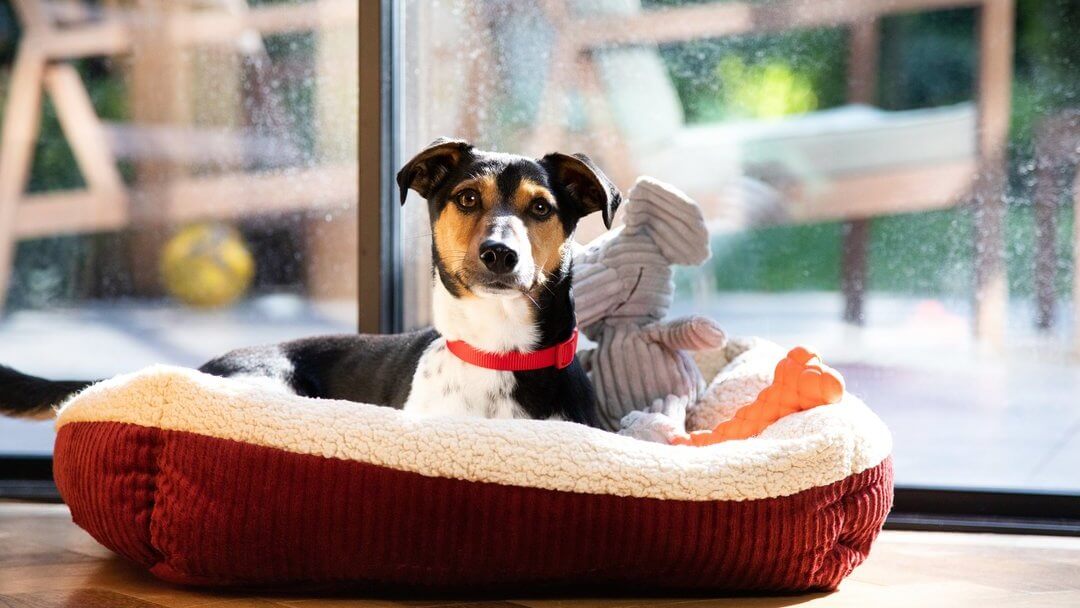On the first night, a dog should sleep in a designated, comfortable spot, ideally on a dog bed in your bedroom or nearby. This location should be consistent and quiet to promote security and sleep routines.
Bringing a new dog home comes with the challenge of establishing a sleep routine from the onset. A good night’s sleep is crucial for your dog’s health and happiness, and where your dog sleeps on the first night sets the tone for your new life together.
Your presence reassures your dog, easing the transition to the new environment. Choose a spot that is warm, safe, and away from high-traffic areas to minimize disturbances. Remember, consistency is key; picking the right spot from the first night will help your dog understand where to rest every night. By making the right choice early on, you’re paving the way for countless nights of peaceful slumber for both you and your new furry friend.
Choosing The Ideal Sleep Spot For Your Pup
Bringing a new dog home is thrilling. The first night sets the tone for your bond and routine. It’s pivotal to choose the right sleep spot. This ensures a tranquil night for both pup and family. A perfect spot helps your dog feel secure and loved. This guide simplifies the process.
Factors Influencing Your Dog’s First Night
- Age and size of the dog matter. Puppies need closer attention than adults.
- Temperament shapes how they react to new environments. Timid dogs need a quiet corner.
- The dog’s previous sleeping arrangements can affect their adaptation.
- House layout including stairs or hazards may dictate the safest spot.
Balancing Safety And Comfort
Create a sleep space that balances safety and comfort. The area should be away from foot traffic but close to family members. Ensure it’s free from hazards. Put bedding in a crate for added security. A soft blanket and a familiar toy can also enhance comfort. Keep the sleeping area consistent for the best adjustment.

Credit: www.preventivevet.com
Setting Up Your Dog’s Sleeping Area
Welcome to the journey of your dog’s first night at home. A cozy and comfortable sleeping area is vital. It aids in a restful night for both you and your new furry friend. Knowing where your dog should sleep on the first night is crucial. It sets the tone for good habits and helps them feel secure. Let’s dive into the essentials for creating the perfect sleep sanctuary for your pooch.
Selecting The Right Bed
The right bed is a must-have for your dog’s comfort. Size, material, and placement come into play. It goes beyond just a simple cushion. Think of it as your dog’s own personal retreat. Opt for a bed that matches your dog’s size and sleeping style. Small dogs often prefer cozy nests, while larger breeds might need more robust, orthopedic options. Place the bed in a quiet corner to foster a sense of safety. Reflect on accessibility, especially if your dog is young or elderly. They should easily step in and out without strain.
Important Accessories For A Good Night’s Sleep
- Blankets: A soft blanket adds comfort and warmth, aiding in deeper sleep.
- Chew Toys: Teething or anxious dogs benefit from having an approved chew toy. It prevents night-time gnawing on undesirables.
- Water Bowl: Keep a water bowl nearby, ensuring fresh water is always available.
- Puppy Pads: Accidents happen. Puppy pads nearby can protect your floor.
Along with these, consider a sleep sound machine or a calming diffuser. Both can help soothe your dog in the new environment. Remember to keep the sleeping area consistently in one spot. This helps your dog understand this is their personal space for rest. Ensure the area is away from high-traffic parts of the house. It should also be free from cold drafts or direct heat.
The Great Crate Debate
Bringing home a new dog sparks the important decision of where they should sleep. One popular option is crate training. Some pet parents swear by it, while others prefer alternative methods. This essential debate centers around comfort, safety, and the well-being of the dog. Let’s delve into the world of crate training and discover if it’s the right choice for your furry friend’s first night.
Pros And Cons Of Crate Training
Crate training has both supporters and critics. Below are key points to consider:
| Pros | Cons |
|---|---|
|
|
Making The Crate Inviting
Once you decide to use a crate, make it welcoming. Here’s how:
- Choose the right size crate for your dog
- Place a comfortable bed inside
- Add a favorite toy for a touch of familiarity
- Consider a blanket over the crate for a cozy den-like feel
- Keep the crate in a quiet area but where the family spends time
- Introduce the crate slowly with treats and positive reinforcement
Remember, the first night is as special for your dog as it is for you.

Credit: be.chewy.com
Sleep Rituals To Calm Your Canine
Welcome to “Sleep Rituals to Calm Your Canine,” the perfect place to discover how to ensure your furry friend has a peaceful slumber on their very first night in a new home. Creating a relaxing atmosphere and routine can aid your dog’s transition. A soothing sleep routine is key to helping your dog feel safe and secure. Let’s dive into establishing these comforting nighttime rituals.
Establishing A Bedtime Routine
A consistent bedtime routine signals to your dog that it’s time to wind down. It fosters a sense of security and familiar patterns they can anticipate. Begin with these steps each night:
- Final bathroom break: Always offer a last chance to go potty.
- Quiet time: Lower the noise and dim the lights to create a calm environment.
- Comfy sleeping area: Ensure their bed is inviting and in a secure spot.
- Gentle play: Engage in soft play that’s not too exhilarating.
- Settling in: Encourage your dog to get into bed with a warm tone.
Soothing Techniques For Anxious Pups
Soothing an anxious pup on their first night is essential for a good sleep. Try these techniques:
| Technique | Description |
|---|---|
| Calming sounds | Soft music or white noise masks startling sounds. |
| Gentle pets | Stroke your dog gently to relax their nerves. |
| Warm blanket | A blanket mimics the warmth and comfort of a litter. |
| Comfort object | A toy with a familiar scent can be very reassuring. |
Navigating Nighttime Challenges

Credit: www.purina.co.uk
Fostering Independence Over Time
Fostering independence in dogs is crucial from the first night they arrive home. It sets the stage for a well-adjusted pet. Teaching a dog where to sleep is part of this process. It promotes confidence and builds a routine. Let’s explore steps to encourage your dog to sleep independently over time.
Transitioning To Solo Sleeping
Nighttime can be stressful for a new pet. Begin by choosing a comfortable dog bed. Place it in a quiet corner. Introduce your pup to their bed with positive reinforcement. Use treats or their favorite toy. A transitional object, like a blanket with their mother’s scent, can provide comfort.
Start with short intervals of solo sleeping. Gradually increase the time each night. This eases your dog into a full night alone. Creating a bedtime routine aids this transition. Include a last potty break and a calming activity. These signals help your dog understand it’s time to settle down for the night.
The Role Of Consistency And Patience
Consistency is key in training your dog to sleep alone. Ensure everyone in the household understands the importance of the dog’s sleeping spot. Consistently lead your dog to their bed at the same time each night. Use a calm, reassuring voice to say goodnight.
Patience plays a huge role in fostering independence. Some dogs adapt quickly. Others need more time. Celebrate small victories. Remain composed even if progress seems slow.
A sleep schedule is vital for your dog’s independence. Stick to regular feeding times. Avoid overstimulating your dog before bedtime. Keep your evening routine predictable. This establishes a sense of security and familiarity. With patience and consistency, your dog will learn to enjoy their own space and sleep peacefully through the night.
Frequently Asked Questions Of Where Should Dog Sleep First Night
Is It Better For Dogs To Sleep Indoors First Night?
Absolutely. On their first night, dogs often feel insecure in a new environment. Keeping them indoors offers comfort, safety, and the start of a routine, which is essential for their adjustment and your peace of mind.
Can Dogs Sleep Alone On The First Night?
While dogs can sleep alone, the first night may be stressful for them. Close proximity to their owner, like sleeping in the same room, can significantly ease their anxiety and promote bonding.
What Are Safe Sleeping Spots For A New Puppy?
Safe spots for a new puppy include a comfortable dog bed or crate in a quiet corner, away from foot traffic. Ensure the sleeping area is not too isolated to help your puppy not feel abandoned.
How To Prepare A Dog’s First Night Sleep Area?
Prepare the area with a cozy bed, a chew toy for comfort, and perhaps an item with your scent on it. Make sure space is safe, enclosed, and that the room temperature is comfortable for them.
Conclusion
Deciding on the perfect spot for your dog’s first night home sets the stage for good sleep habits. Aim for a balance between comfort and security. Whether it’s a cozy crate or a quiet corner, prioritize your pet’s needs for a smooth transition.
Remember, a restful first night leads to a happy, healthy dog.
